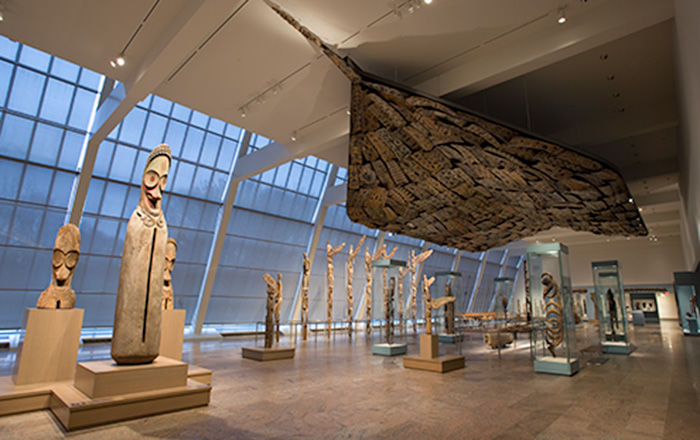Solitary Female Huia
Fiona Pardington Maori
Not on view
‘I think that photography is very much a place of mourning for the things that are valuable in life.’
- Fiona Pardington
This work is one of a series of important portraits of huia birds, photographed in museum collections, by renowned photographer Fiona Pardington. The distinctive, white-tipped tail feathers were worn as head adornments to signify chiefs and people with mana, those who possess great authority and power. The huia (Heteralocha acutirostris) was a majestic bird with vibrant orange wattles, shiny black feathers and white-tipped tail feathers. Huia had twelve long glossy black tail feathers, each tipped with a broad band (approximately 2.5-3 cm) of white. For Māori the huia was revered as a symbol of nobility and leadership and worn only by those of chiefly rank. who were permitted to wear huia feathers in their hair or whole skins suspended from a perforation in their ears. Unfortunately, the bird is now extinct, with the last recorded sighting in December 1907. Predation by introduced mammals and, to a lesser extent, human hunting, was the likely cause of huia extinction. There was a rapid decline in their numbers in the late 19th century, probably because of a combination of bush clearance, predation by introduced mammals and hunting. Legislation to stop the birds being hunted was passed in 1892, but it was too late to avoid their extinction, which happened in the early 20th century.
Fiona Pardington is drawn to the subjects in museums whose weighty histories and spiritual intensity she can explore. Though the highly controlled, almost contrived arrangement of static objects in some of Pardington’s compositions are evocative of still life, aligning with the European vanitas tradition, artworks such as Solitary Female Huia also engage with elements of portraiture. Pardington’s connection to her subjects is clear: “I’ve personalised them, made portraits of them,” she explains, “and just treated them like they were individuals.” The taxidermied specimen may thus illustrate the birds’ extinction, but the artist strives to restore its dignity, creating a far more intimate presentation of the bird as a solitary, once living creature.
Pardington has immersed herself for many decades in subjects that are hidden from plain sight or rarely afforded attention. The archived collections of museum stores have offered a particularly rich seam of material for Pardington to explore through her camera lens. Early in her career, the artist developed an interest in analogue darkroom techniques, most notably hand printing and toning which she has come to specialize in. Her photography has always examined the material potential of tonal qualities, and the discharge of light, in a consideration of how one might connect the material with immaterial (or spiritual) realms. The artist’s intention is to guide a reflection on the transition across fragile borders, and lightly perceived thresholds, including those that exist between the past and the present; between life and death). Pardington’s saturated images of now extinct birds celebrate the genre of still-life imagery with a painterly quality that visually reference 17th century painting traditions as well as 16th century vanitas traditions. The images are not only memento mori in terms of their poetic reflection of the certainty of time passing, they also embody the fraught, yet inevitable, encounter (or violent clash) of cultures when these confront each other.
The cardinal characteristics of the huia are elevated in Solitary Female Huia. The glossy black plumage fuses with the background, yet the precise lighting draws the eye to the striking bill and bright wattle. The elegant, slender curving bill identifies the subject as female (since the male species are known for their heavier, shorter and less curved bills). The dim, intentional lighting enhances the intensity, and spiritual dimension, that Pardington strives for in her work. The deep, sumptuous inky black backgrounds are a consistent aspect of her oeuvre. Despite the fact her avian subjects are sourced from the shelves of museum repositories, Pardington’s ambition is to strip away any scientific framing or museological undertones. Lifting her subjects out of the sterile environment of the cabinet or museum storage facility, the artist directs the consciousness of the viewer to engage with the living ahua, and agency of the once living creature they now encounter. Pardington’s works embody, rather than simply critique, the complexities of the archive, of museums, of life itself. Using long exposures and measured bursts of light Pardington sets out to reveal the mauri (life force) expressed as light and energy that (from a Maori perspective) is held within living beings. Pardington uses the phrase ‘a beautiful hesitation’ to describe photography’s power to pause time and transcend the conditions of the material world. Her practice breathes life into the objects she encounters. Her long-term investment in working with museum collections is a way to liberate the works from museological systems of display and classification, most (especially the so-called ‘orphaned’ works that have no provenance) so that she can assist in returning them to the light. The work mourns the loss of the endemic huia species whilst eliciting reverence for this particular bird.
